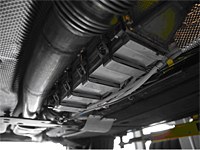Car exhaust gases as a source of electricity?
The first test vehicles are already being equipped with thermoelectric generators. At BMW, a prototype of a thermoelectric generator for use in vehicles has been developed in cooperation with the DLR Institutes of Vehicle Concepts in Stuttgart and Materials Research in Cologne. Like all thermoelectric generators, this mini power station uses what is known as the Seebeck effect. In the Seebeck effect, an electric voltage is created between two points on an electric conductor if there is a difference in temperature between those two points. The reason is that the electrons move faster at the hot end of the conductor. Hence, the electron density is decreased at that point in comparison with the cold end. This imbalance causes an electric voltage to be generated, which can be used in an electric circuit. If this electricity is fed into the vehicle’s onboard power system, a thermoelectric generator can reduce the load on the conventional electric generator, the alternator, but it can never completely replace it. Nevertheless, this can achieve fuel savings of five to seven percent, according to the experts.
However, much development work remains to be done by the researchers before whole vehicle fleets can be equipped with such thermal power systems. They are currently searching across the world for the ideal thermoelectric material. Although the most efficient heat to electricity converters already achieve an output of several hundred watts, they often consist of expensive or toxic materials, such as bismuth telluride, which is currently the most commonly used substance.

Researchers on the hunt for new materials
Japanese researchers recently succeeded in creating the Seebeck effect in low-priced and non-toxic magnesium silicide. Unfortunately this material alone only converted eight percent of the available thermal energy into electricity, but in a two-stage configuration with bismuth telluride that figure did rise to 12 percent. Hope does not, however, rest solely on completely new materials. Known materials can also be improved by creating a controlled, nanostructured configuration. The aim here is to achieve a significant increase in the efficiency of electricity generation. Initial experiments with such nanostructures at the DLR Institute of Materials Research in Cologne have produced promising results but are still far removed from low-cost mass production.
The search continues and is anything but simple, but it is worth the effort. If the breakthrough is achieved in the foreseeable future, thermoelectric electricity generators could be installed in millions of cars and diverse other energy systems. If, in this way, cars’ thirst for petrol is reduced by only a few percent, huge quantities of fuel could be saved each year and many thousands of tonnes less of the greenhouse gas carbon dioxide would be emitted into the atmosphere. Until that time, thermoelectric modules are being successfully used in important niche areas. These include, for example, the supply of electricity for small, independent sensors and the operation of space probes or planetary lander robots in space.
Tags:
